“But that’s not reeaalllly Filipino food though isn’t it?”. Definitely an if-I-had-a-penny question if I’ve ever heard one mentioned. Talking about the cultural aspects of food is so difficult that I’m constantly tempted to drop the label and just call it…”food”; pure, unadulterated, homogeneous, boring, it-just-is, food. Of course that’s just as irresponsible as creating imaginary divisions by arguing what makes a food Filipino (or *gasp* “authentic”) enough but it’s tempting nonetheless. But what IS Filipino food anyway? Who gets to decide and mandate the confines by which it’s labeled by? Is there some tome or someone’s lola I can just go to and get a final say?
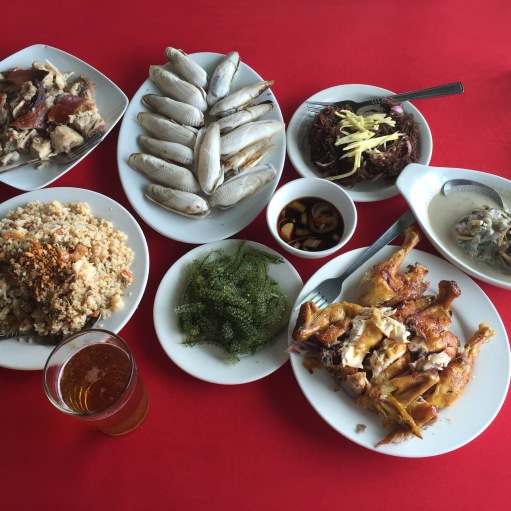
Seafood, crab fat rice, native chicken – Breakthrough Restaurant, Iloilo
You hear of people who try to find the answers through books and old recipes, others plan Instagram-fueled trips to the motherland replete with pristine food porn trying to “find their roots”. But I’d risk assuming that for most, what does or doesn’t make the cut for the Pinoy food roster is nothing more than what people were fed during the times they were the most suggestible in life. My idea of Sinigang, the Filipino sour soup, was one made with lemons and Mackerel since Saudi Arabia was devoid of tamarinds and milkfish or pork and when your typical Tita Girlie scowls and says “but that’s not reaaallly Filipino food though isn’t it?”, it does feel like your very identity is being questioned a little bit.
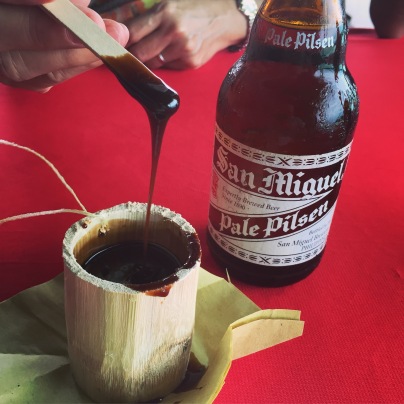
I too went back to the Philippines for an extended work trip and while I expected to definitively state what makes a certain dish Filipino, such an endeavor proved harder than your corner kalinderya‘s Bistek. For every dish I tasted and every home cook I chatted with, I left with more questions than answers.

Typical rice cakes at a kalinderya (cafeteria) – Cubao, Manila
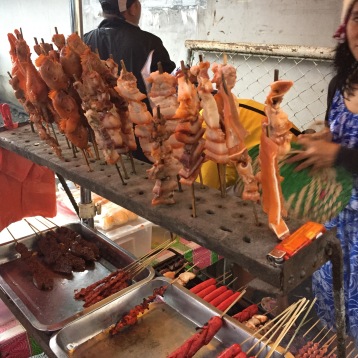
Typical meat cuts at a roadside BBQ – San Jose, Antique
Is what makes something Filipino its ingredient? Do they have to be endemic to the Philippines? What makes Adobo as the majority cook it (meat stewed in vinegar + soy sauce) Filipino when soy sauce is Chinese? How about if said Adobo was cooked with local coconut milk, the resulting dish unsurprisingly engendering the dislike of several diehard Tito Boys? If Laswa, a Visayan vegetable soup, was cooked with a packet of MSG-laden Magic Sarap as I had it, of all places, on a farm surrounded by fresh produce, is it still Filipino? Why would the Beef Kulma of Mindanao, a curry akin to the Kormas of the Mughlai kitchens, have its Filipino-ness be questioned at a friend’s pop-up dinner yet few would hesitate to call our many pastries of French origin like the Sans Rival anything but Pinoy?

Pinakbet – Yellowfin Restaurant, Davao City
Or perhaps a dish’s Filipino-ness resides in the soul of its cook. If a Pinoy lolo in frigid Minnesota started remixing the goat stew kaldereta into a beef one that didn’t use as many tomatoes but instead added a seemingly misplaced spoonful of peanut butter, is his dish more Filipino than the Dominican chef who travels to the Philippines and takes the time to taste the local bounty? Would the essence of a dish be destroyed if a more refined technique, no matter how good, was applied to it? If a cook were to clarify the stock used in Batchoy – a scalding mixture of hot soup, noodles, and cheap cuts – rather than allow the scum to sit in the pot…or if she were to blanch the vegetables in Pakbet rather than letting it turn into mush, is she less of a Pinoy?

An Abundance of Brown – Casa Ilongga, Pasay City
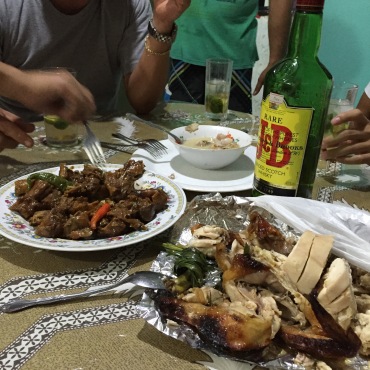
An Absence of Green – Sibalom, Antique
Or maybe the food just has to “look” familiar: heaped into steam tables and bins from the turo-turos of our childhood. Brown, uniform, greasy, laden with meat. Would carefully plating it be deemed as pandering to “the Amerikanos“? Or that the resulting refined cuisine never be supported by the true bloods because Filipinos as a whole are “too cheap”?

A fresher Halo-Halo – Veggie Wok, Iloilo City
I couldn’t really tell. Yes…the dishes our elders proclaim we are not honoring because it isn’t how they remember them are ever present back home: on the streets, in the food courts, and in our homes. Yet this wasn’t the only Filipino food I ate and saw. There were artistically rendered takes on classics that intensified the flavors I so remembered, regional versions of national dishes that diners fail to recognize as having been around long enough to be called “traditional”, local staples made from scratch rather than succumbing to the slow seduction of Magic Sarap and ready-to-mix sauce packets.
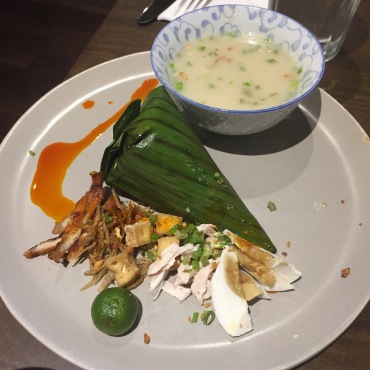
Arroz Caldo “Parcel” – Kafe Batwan, Makati

Interesting twist on Eggs Benedict – The Goose Station, Taguig City
All around the local palates changed as fast as Metro Manila’s skyline and one has to wonder whether perhaps it is us, who’ve spent too long cooking the same things and living in our imagined visions of what a truly Filipino experience is, who are out of touch; Narcissus staring at the Adobos of yesteryear. Perhaps we forget that as our people change and walk this Earth, our cuisine can’t possibly make it out unchanged.

I don’t have the answers to many of my questions. I actually don’t think they can be answered at all. Perhaps all the debates really are just illusory and that even a trip home will never yield an answer to an ever-changing question. Perhaps when it comes to Filipino food (or any food for that matter), it is everything and nothing all at once, simply meant to be savored, not dissected.
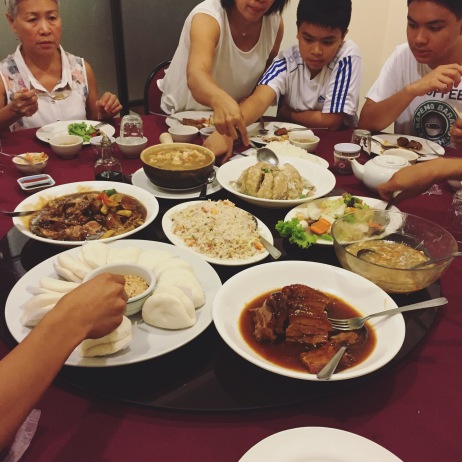
Thank you! As a mestiza born in Manila to a Bronx-Irish dad & Davaoan mom, raised in Angeles City, transplanted to the States in the 1980s where I was dubbed Chinese because it was the only Asian heritage 6th graders had awareness of, I have lived the experience of Filipino-ness being questioned. And yet, when it comes to Filipino food around NYC, I’m just as guilty. I love seeing more Filipino chefs/restaurants, and even influences popping up in different places. I waver between some kind of national pride, but then kind of shake my head at StreetsBK’s take on adobo chicharrones, because I don’t know what sugarcane vinegar is, but I know it’s no Datu Puti. I like the elevation and awareness of our cuisine within the cultural vernacular, but yep, give me a turo-turo any day.
LikeLike
Waaiiitt…I completely forgot you’re in NYC! We should break bread.
LikeLiked by 1 person
Yes! I’d love to catch one of your dinners one of these days…
LikeLike
Mouthwatering article
LikeLiked by 1 person